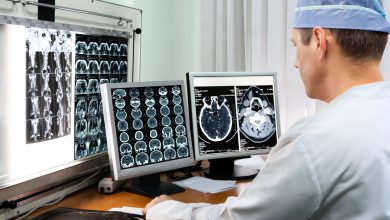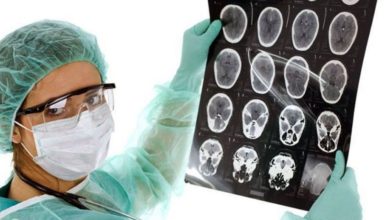Brain tumor - treatment methods
The content of the article
Currently, despite high-tech research methods, scientists have still not figured out the 100% reason why a disease such as a tumor occurs.
The brain is the most complex organ in the human body. It consists of ten billion neurons, which make about thirteen trillion connections among themselves. It is a highly complex system even compared to the latest computer. Despite its complexity, most of the brain is made not of neurons, but of supporting cells. The main part of these cells are astrocytes. They serve the main cells of the brain - neurons. There is also another type of cell, there are much fewer of them, but they are designed to protect nerve fibers - myelin synthesis.
Chronic lack of sleep, poor diet , constant worries, stress at work and in everyday life lead to the fact that the brain cannot rest peacefully at least at night, which leads to disruptions in its functioning.
The question often arises - what is a brain tumor? This is an intracranial neoplasm, benign or malignant, which arises as a result of the onset of the process of rampant and uncontrolled cell division. Until this point, they were normal components of the tissues of the organ, the lymphatic system, blood vessels, cranial nerves, meninges, skull, pituitary gland and pineal gland, or arose as a result of metastasis of a primary tumor in another organ and penetrated into the brain.
The causes of this disease can be different, for example, gene mutation, heredity, negative effects on the body of certain factors, substances, radiation.
What are the types of brain tumors?
There are primary and secondary neoplasms. Primary ones arise in the tissues of the brain or in its membranes, cranial nerves when a DNA failure occurs in normal cells, i.e. gene mutation. This leads to the fact that cells begin to divide very quickly and grow at high speed. As a result, new formation of pathological cells occurs.
They are less common than secondary ones. But there are many varieties that depend on the type of tissue in which this tumor arose:
- Ependymoma.
- Acoustic neuroma.
- Astrocytoma.
- Pineoblastoma.
- Glioma and glioblastoma.
- Oligodendroglioma.
- Ependymoblastoma.
- Neuroblastoma.
- Meningioma.
- Medulloblastoma.
Secondary appears due to a malignant process in various organs that penetrate (metastasize) to the brain. Sometimes, cancer occurs much earlier than the neoplasm itself is detected. It happens that this disease is the first sign of cancer that has arisen in another organ.
Secondary tumors are more common than primary tumors. Moreover, any of these types can be distributed in the brain.
The most common are:
- Sarcoma.
- Mammary cancer.
- Neuroblastoma.
- Colon cancer.
- Melanoma.
- Kidney cancer.
- Lungs' cancer.
Causes of the disease
Doctors are not entirely sure what causes the genetic mutations that lead to the development of primary tumors, but they have identified factors that increase the likelihood of developing such a disease:
- Age: The risk of getting sick increases with age. Most tumors occur at ages 45 and older, although the disease can occur at any age. There are also some types that occur only in children, such as medulloblastoma or benign cerebellar astrocytoma.
- Exposure to radiation: The risk increases for people exposed to ionizing radiation, such as radiation therapy used to treat cancer and radiation caused by atomic bombs, as well as man-made disasters resulting in radiation exposure. Electromagnetic fields from high-voltage power lines, radiation from a mobile phone and a microwave oven still remain unproven factors that provoke the growth of brain tumors.
- Exposure to chemicals or carcinogens at work. In some workplaces, employees are at risk of developing the disease due to exposure to chemicals in the workplace. Research does not fully confirm this fact, but in some industries there are elements of increased risk, for example, agriculture, electromechanical industry, oil refineries, healthcare.
- Family predisposition, heredity. There are situations when a brain tumor occurs in people who have received a predisposition by inheritance, for example, when family members have been exposed to such a disease or have genetic syndromes that increase the likelihood of the formation of infected tissue.
Treatment
This disease can appear in different parts and can be either malignant or benign. The tumor grows quickly and is difficult to treat. This type includes all types of gliomas , medulloblastomas and others. They can also differ depending on the age of the patient and the degree of spread and its malignancy.
Operation
If the tumor is located in a place that is easily accessible for surgery, then the surgeon will try to remove it completely. When it is small in size and can be easily separated from the brain tissue, then surgery to remove it is completely justified. If the tumor is located in particularly sensitive areas of the brain, then the operation is performed very carefully so as not to damage the tissue. Sometimes removing even the smallest portion of infected tissue can reduce symptoms and signs of exposure. Naturally, with brain surgery, there are risks during removal, such as infection or bleeding. All procedures are carried out using an operating microscope, navigation equipment, and anesthesia.
Radiation therapy
To destroy cells, radiation therapy is used, which uses high-energy particles, which can also be X-rays. There are external beam radiation therapy and close-focus radiation therapy.
In remote therapy, the device is placed outside the patient's body. With close-focus, the radiation source is located in the patient’s body, close to the infected site itself.
The accompanying symptoms that occur during radiation therapy treatment vary depending on the type and dose of radiation used. The main ones will be: headache , fatigue, weakness and irritation of the scalp.
Currently, new methods of remote irradiation are known using a gamma knife, linear accelerator and cyber knife.
Chemotherapy
This procedure involves the use of drugs to destroy tumor cells. These drugs are taken orally or through intravenous administration and they are distributed throughout the body, and they can also be administered into the spine, affecting only the patient’s nervous system.
The use of chemotherapy can also occur during surgery, when the surgeon removes part of the tumor and places a capsule or several capsules with a chemotherapy drug in the space free from the lesion. Within a few days, these capsules dissolve and thus the chemotherapy drug affects the remaining part of the infected area. The side effects of chemotherapy largely depend on the dose and type of drug used. Mainly manifested in the form of nausea, vomiting, hair loss.
How to recognize a brain tumor in the early stages?
There are some symptoms that appear when this disease occurs:
- Pain in different parts of the head, and the pain may intensify when changing the position of the head, turning, or sneezing. When taking painkillers, pain almost does not decrease.
- Dizziness. An attack of dizziness can occur suddenly: when walking, at rest, during sleep. The appearance of dizziness is associated with increased intracranial pressure due to the influence of the tumor on some part of the brain.
- Fatigue, drowsiness. A constant feeling of tiredness, no matter how much a person rests.
- Hallucinations: Auditory and visual hallucinations may occur, depending on the effect of the tumor on different parts of the brain.
- Problems with memory. The patient may even forget the names of some objects, things, and sometimes not recognize loved ones.
- Vomit. It can occur regardless of food intake, on an empty stomach, without prior heartburn or belching. It can be sudden, non-stop, gushing.
Vomiting, as one of the symptoms of a tumor, is sudden. Does not directly depend on food intake. Mainly associated with changes in body position. It can appear in the morning, on an empty stomach, after meals and before meals. In most cases, it occurs against the background of a severe headache. The cause of this symptom is usually the pressure of the tumor on the vomiting center of the brain; this also increases intracranial pressure, and vomiting does not bring relief. The manifestation of this symptom indicates that the infected cells are located within the posterior cranial fossa.
What does a brain tumor look like?
A benign neoplasm has clear boundaries when examined on MRI and computed tomography (CT) scans, and there is no metastasis.
A malignant neoplasm does not have clear contours and boundaries, it is distinguished by rapid growth and the presence of metastases, spreading to neighboring areas of the organ and through the cerebrospinal fluid.
The doctor needs to determine immediately what causes a brain tumor at an early stage, as well as the reasons for the occurrence of certain symptoms. The size of the tumor can be different, small and large, but no matter the size of the tumor, it is still dangerous to human health, because it compresses the brain tissue, which leads to the death of nerve cells, the blood flow to various parts decreases or even stops heads. This leads to disturbances, changes and disappearance of important brain functions, problems with hearing, vision, movements, speech, and sensitivity of the body arise. In severe cases, this leads to death.
Meningioma
The next most common type is meningioma . It develops in the dura mater of the brain and has a corresponding name.
There is a neoplasm that arises from astrocytglia (auxiliary cells of the brain) and has four degrees of malignancy:
- pilocytic - 1 degree,
- fibrillar - 2nd degree,
- anaplastic - 3rd degree,
- glioblastoma - stage 4.
Oligodendroglioma arises from oligodendrocyteglia and has 4 degrees of malignancy, like astrocytoma .
Ependymomas develop in a thin epithelial membrane in the ventricle of the brain. Appears with the formation of metastases, accounting for 10% of all cases of intracranial neoplasms. Hemangioma arises from vascular cells in the head.
Neuronal and neuronal-glial manifestations of formations are of several types:
- gangliocytoma (benign neoplasm),
- ganglioneuroblastoma,
- neuroblastoma, which arises from ganglion cells. If it is divided inside by bundles of glial cells, then it is called neuronal-glial.
Fetal types of brain tumors develop in utero and are very rare and dangerous. If the disease is detected at an early stage, it can be cured.
Please rate the article:





